‘Count Like an Egyptian’
In his new book, associate professor David Reimer shows how ancient Egyptian mathematics—more art than algorithm—shaped everything from pyramids to property lines.
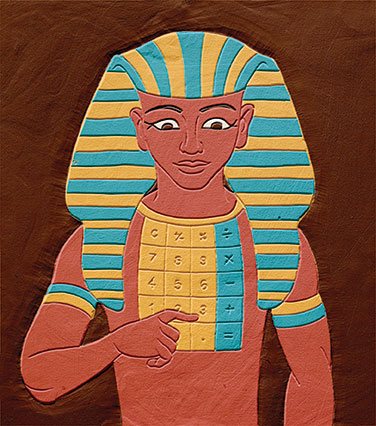
The Pyramid of Giza may be one of the Seven Wonders of the World, but before this 4,600-year-old architectural masterpiece was built, ancient Egyptians had—to put it charitably—a notable false start.
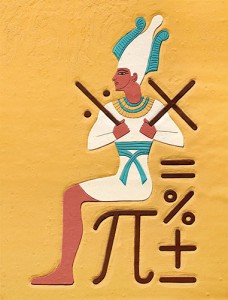
Fifteen years before the Pyramid of Giza broke ground, the Pharaoh Sneferu oversaw the construction of what is believed to be the first-ever pyramid with smooth, rather than stepped, sides. The plans were grand. The sides were steep. And halfway through construction, the pyramid began to crumble. The 54-degree angle was simply too steep to maintain. The builders scrambled to salvage the massive structure by changing the pyramid’s angle to a more moderate 43 degrees. Today, the wonky-looking structure—known as the Bent Pyramid—still stands.
Egyptians had learned the hard way about the limits of pyramid construction and the power of mathematical slope. The pyramids that followed, like the more famous one 20 miles north in Giza, were steep—nearly 52 degrees—but the angles were never quite as sharp as those that nearly did in Sneferu’s project.
Associate mathematics professor David Reimer tells a version of this tale in his book Count Like an Egyptian, not to critique ancient building methods, but to raise a larger point about how ancient Egyptians thought about mathematics. Slope was never an abstract concept plotted out on graph paper with x and y axes. “Egyptians were very practical people,” says Reimer. “[The idea] of slope arose because they needed to figure out how steep to make a pyramid so it wouldn’t fall on top of them.”
Reimer’s new book may be nominally about mathematics, but he says it’s really about how mathematics—often seen as an abstract and unchanging set of principles and processes—is deeply influenced by the culture that uses it, and provides a window unlike any other into the values that a society holds most deeply.
It’s all hieroglyphics to him

Reimer’s initial study of Egyptian mathematics was borne of pure pragmatism. He’d just taken a job at TCNJ in 1999, and Siegfried Haenisch, the previous instructor of the department’s history of mathematics course, had retired. Reimer, the new guy, offered to take on the responsibility.
As he brushed up on his history, he found that ancient Egyptian math proved to be a particular puzzle. There is just one known complete Egyptian mathematics text, what’s known as the Rhind Mathematical Papyrus, and just about everything else linked to it, such as journal articles and other scholarship, was nothing short of dreadful. “The authors [of the articles] would express ideas in terms of algebra, which is meaningless, because algebra didn’t exist then,” he says. “It’s like trying to talk about the pyramids in terms of jackhammers and forklifts.”
So he turned back to the original textbook and went through it methodically, page by page, problem by problem. He solved all of the problems, but the way he came to the answers was messy compared to the elegant solutions in the book. He stared at the problems for hours, trying to understand the leaps of logic and critical insights that led from Point A to Point B. Then he went through the textbook again. And again.
The more he learned about Egyptian culture, the more he appreciated the way that their mathematics reflected the specific problems they were grappling with as a society. For example, Egypt had a socialist-style government. As part of that approach, farmers each received equal-sized plots of land to grow their crops. But the Nile’s constantly shifting shores meant that those plot boundaries had to change each year to maintain equal areas for each farmer; surveyors redrew property lines every single year. “The government ran almost the entire economy, and because of that, they needed a horde of accountants to watch over everything,” Reimer explains. “Their mathematics rises out of a need for managing an empire that’s something like a thousand miles long.”
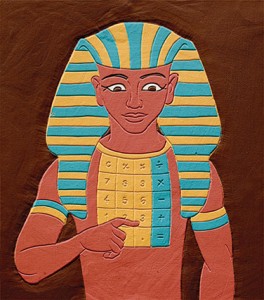
Reimer compares the rise of specific kinds of math in Egypt with the development of mathematics during the rise of Athens: both were a product of their times—and their cultures. In Athens, for example, where democracy was on the rise, persuading others to share your view was important. And just as politicians and citizens honed logical arguments to make their points, mathematicians developed mathematical proofs, which were the purest form of logical argument. “It’s surprising how cultural math is,” Reimer says. “These [concepts] didn’t just arise because someone was sitting around and thought of something. It happened in the context of what they were doing in the rest of their lives.”
The perspective Reimer gained from his studies also made him realize the shortcomings of the math we do today. Elementary school teachers, for example, spend years drilling their students in seemingly arbitrary multiplication tables. However, in Egyptian math, the problems are laid out in a way that makes them feel much more like simple addition; the answers may be the same, but the process of getting there looks far different, and memorization is not required. Reimer finds that after a relatively brief introduction to the Egyptian approach, students can solve such problems far more quickly.
The deeper Reimer dug into Egyptian mathematics and history, the more he wanted to share stories where math, culture and ideas intersected.
Writing a book that stands the test of time
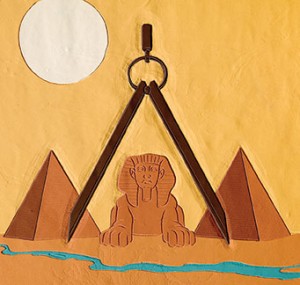
Reimer wrote his first draft in his home’s basement office. He wrote stories about ancient Egyptian gods and ambitious Egyptian pharaohs. He wrote about bread and beer. He wrote about pyramids and the workers who built them. And he explained the way that mathematics intersected with all of these aspects of ancient Egyptian society, complete with problems to consider and solve.
Integrating the math into the book in an accessible way often proved challenging. Reimer says that for all its strengths, Egyptian mathematics can be daunting at first. He compares it to riding a bike: The learning process has so many moving parts that it often seems like it will be impossible to master, until suddenly it becomes intuitive and unforgettable. To make sure his explanations resonated, he spent countless hours testing chapters with his students—both math and non-math majors—so he could see where they got stuck solving problems, and where he needed to make revisions.
For some, including Reimer himself, the Egyptian way of thinking about math is deeply satisfying. “Today, we’re taught to do math in a step-by-step way—you do this step, then this one, then this one. If you follow exactly what you’re told, you get the right answer,” Reimer says. “But in Egyptian math, there are any of maybe five to eight tools that you can apply. It’s not a mindless algorithm; it’s more like a Sudoku puzzle.”
Count Like an Egyptian, out since May, has been received warmly by critics and earned a positive review in The Washington Post. Reimer has appeared on news programs to promote his book, and has given several talks, including one at the Smithsonian.
Reimer is eager for his readers to see the creativity and life that are deeply embedded within an ancient system of mathematics. In the same way that sports fans understand that baseball is about so much more than statistics in agate type in the morning’s newspaper, Reimer wants to show his readers that the joy of Egyptian math comes not from the beautiful numerical symbols or the elegant equations. It comes from digging into everything that goes on beyond the page. “Talk all you want to someone who’s never experienced baseball, but he will never understand it until you put him on a field and throw a few pitches,” he says. “Suddenly the game makes sense. The same is true here. I don’t want to talk about [ancient Egyptian mathematics] abstractly, in an academic way. I want people to get their hands dirty.”
Lessons from a Lost World
To make ancient Egyptian math accessible—and to give readers a better idea of the culture in which it was used—Reimer pulled in stories and factoids in every chapter. Here’s a look at what ancient Egyptian math can teach us about a lost world.
Lesson 1: You can count on it
Ancient Egyptian numerical symbols are a bit like Roman numerals—but with characters that are decidedly more delightful than their Roman counterparts.

The format for writing a number in ancient Egyptian is very similar to that of Roman numerals. The number 231,427, for example, would be written:
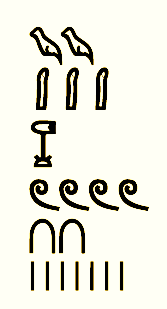
Lesson 2: And you thought Facebook collected too much data about its users
Mark Zuckerberg doesn’t have anything on Egyptian bureaucrats, who were charged with collecting massive stores of information on everything their citizens were doing and producing. Writes Reimer: “[Scribes] were there from a person’s birth to their death, recording all. [They] were on the farms, in the storehouses, and on the factory floors. They were even on the battlefields, recording the details of the fight and tabulating the casualties by counting thousands of hands severed from the dead.”
Lesson 3: All those bait-and-switch Internet headlines had a precursor, and his name was Ahmose
Any Internet headline that ends with “…and you’ll never guess what happens next!” is almost sure to overpromise and underdeliver. But if you think the Internet is to blame for these shady baiting tactics, think again. The scribe Ahmose, who lived more than 3,500 years ago, may have them all beat. During his lifetime, he wrote a scroll titled Accurate Reckoning, the Entrance into the Knowledge of All Existing Things and All Obscure Secrets. But before you head out to pick up your copy and achieve enlightenment, heed Reimer’s (spoiler alert!) advice: “Modern school children [will] probably be disappointed to learn that this is a title to what is only an introductory book on fractions,” he writes.
Lesson 4: A number that’s one in a million
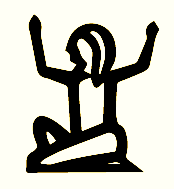
Ancient Egyptians rarely needed to count into the millions, but that doesn’t mean they didn’t have a number for it, writes Reimer. “Egyptians used this word to represent extremely large numbers in exactly the same way we do when we say we’ve done something ‘a million times.’” So what’s behind that funny little guy with his hands thrown into the air? It’s difficult to say, says Reimer, but experts have a few guesses: “Some have suggested it’s the arms of a man outstretched, overwhelmed when confronted with the concept of infinity. It’s also reminiscent of the pose the air god Shu takes while holding up the sky, restraining her from embracing her lover, the Earth. The symbol also stands for each of the Heh gods. These are the spirits of Ogdoad, who died to form the Earth and coincidentally help Shu hold up the sky.”
Lesson 5: Blame the capitalists: How movies get the ancient Egyptian economy all wrong
Hollywood may be great at telling stories, but accuracy isn’t always its strong point, writes Reimer. “Contemporary movies about the ancient world seem to invariably include scenes of a vast marketplace where the characters are offered a wide array of treats and forbidden goods. This imagery is based on a modern misconception,” writes Reimer. “The economies of ancient civilizations were, by and large, controlled by a central government. The state provided everything its ruling class thought the citizens needed, and the former took what they considered to be their share. When not working for the government, individuals would occasionally exchange goods and services with each other for a few items the government wouldn’t provide. Relatively speaking, it was a small part of the economy, which was otherwise dominated by Egypt’s ruling class.”
Posted on September 29, 2014

